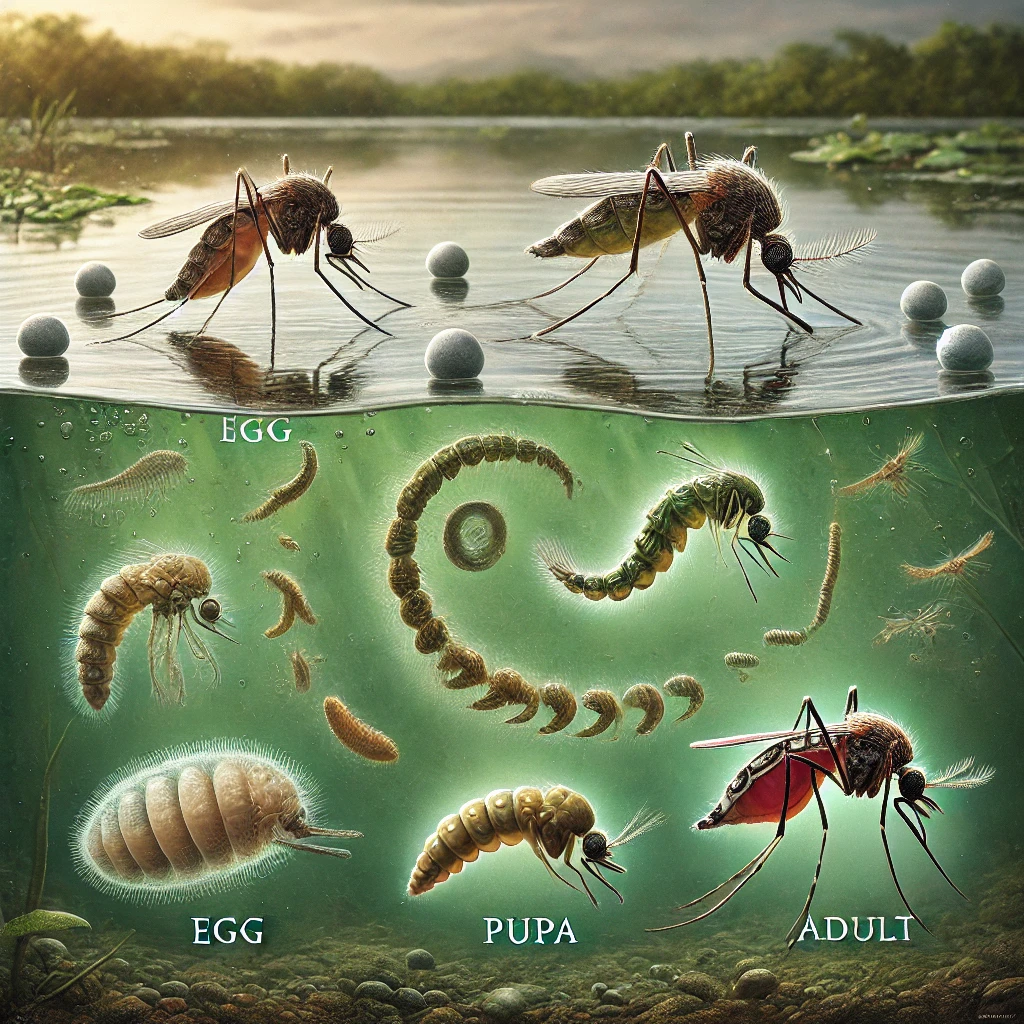
The Mosquito Life Cycle: Understanding to Control
Mosquitoes are insects that, aside from being bothersome, can transmit diseases to humans and animals. Understanding their life cycle and mating habits is a key step toward implementing effective control strategies. In this article, we will explore each stage of the mosquito’s development—from egg to adult—and review why knowing these processes is essential for reducing their proliferation.
A Complete Cycle in Four Stages
Mosquitoes undergo a complete metamorphosis with four stages: egg, larva, pupa, and adult. Each stage depends on specific environmental conditions and factors, such as temperature, humidity, the availability of standing water, and the presence or absence of predators.
- Egg:
Females lay between 100 and 300 eggs in stagnant water or on moist surfaces, sometimes creating floating “rafts.” These eggs hatch within 24 to 48 hours under favorable temperature and humidity conditions. If conditions are not ideal, eggs may enter a state of dormancy, waiting until the environment improves. - Larva:
Once hatched, larvae live in water and feed by filtering microorganisms, algae, and bacteria. They breathe atmospheric oxygen through a siphon that extends above the water’s surface, minimizing their exposure to predators. This stage lasts from 4 to 14 days, during which larvae go through four “instars,” molting their exoskeleton each time to allow growth. Larvae are often found in stagnant water sources like puddles, blocked gutters, containers, or any object that can hold even small amounts of water. - Pupa:
The pupal stage is one of transformation. Pupae do not feed; instead, they use stored energy to undergo metamorphosis. They breathe through trumpet-shaped structures and can move to avoid threats. Lasting from 1 to 4 days, this stage reorganizes the larval tissues into the adult mosquito’s form. - Adult:
The adult mosquito emerges from the pupal case on the water’s surface. It needs time for its wings and exoskeleton to harden before it can fly. From this moment on, males typically feed on nectar, while females seek blood to obtain the proteins necessary for egg development. This blood-feeding behavior, coupled with their ability to mate in midair and store sperm for subsequent egg batches, allows females to reproduce multiple times during their lifespan.
Mating and Reproduction
Male mosquitoes form swarms in specific areas, and females are attracted by these aggregations as well as by acoustic and chemical signals. After mating, the female does not need to mate again to produce new batches of eggs. This allows her to lay multiple clutches throughout her life, as long as she has access to a blood source.
Factors Influencing Their Development
Temperature, humidity, the quality and quantity of available water, as well as the presence of predators, parasites, or chemicals, directly impact each stage of the life cycle. A suitable environment accelerates development, while unfavorable conditions can slow it down or even induce dormancy in eggs and larvae.
The Importance of Understanding the Life Cycle
Understanding the mosquito’s biological cycle is crucial for controlling their populations. Knowing where larvae develop allows for targeted action:
- Eliminating Breeding Sites: Emptying containers with standing water (buckets, tires, vases, planters), cleaning gutters, keeping lawns trimmed, and removing items that can collect moisture.
- Biological and Chemical Control: Applying larvicides in wells, cisterns, or permanent water sources, and considering the introduction of natural predators (such as certain fish) where feasible.
- Physical Barriers: Using screens on windows and doors, as well as bed nets, helps prevent bites.
- Personal Protection: Wearing long-sleeved clothing, using repellents, and avoiding exposure during peak mosquito activity times (dawn and dusk) reduces the risk of bites.
Knowing the mosquito life cycle enables strategic intervention to reduce populations and minimize health risks. Understanding their needs, habitats, and the conditions they require provides tools to break the life cycle at its most vulnerable stages—especially during the aquatic egg and larval phases. This approach leads to more sustainable and effective solutions, protecting the health of your family and the broader community.
Remember: If you need professional help to control mosquitoes, do not hesitate to contact an expert service like Eco Fauna Control, which has the tools and experience needed to advise you and solve the problem comprehensively.
